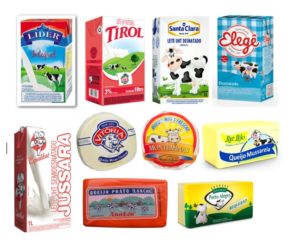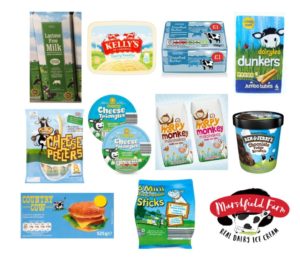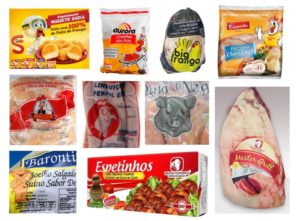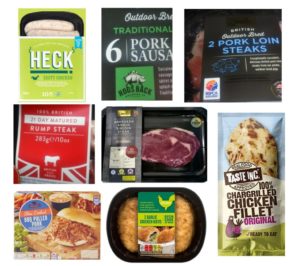How marketing represents animals in animal products packages in Brazil and in the United Kingdom by Karynn Capilé
People usually have deficient knowledge about how animals are raised for food production as well as the conditions and features of livestock and animal exploitation. For this reason, what is said, suggested or even hinted about animals in animal products marketing matters: the images and messages of animal products displayed in packages and on a brand’s website might be an important criterion in the consumer’s attitude and understanding of the animals they consume. However, the purpose of the package or website design is to promote the product, regardless of whether it matches the reality of the animal lives used to make it.
From a critical perspective, consuming animals implies damage for the animals as subjects and for anyone potentially affected by the environmental conditions, when it could be replaced by plant-based food sources, and this is something to take seriously as a social problem. The objective of this broader study is to analyse how marketing represents animals in packaging, and in due course to discuss how it might intervene in the consumer attitude toward animal consumption. In a preliminary analysis of the animal product packages at popular supermarket chains from Brazil and in the United Kingdom*, it was observed that milk and dairy product packages and websites from both countries usually display bucolic landscapes with funny and childish styles where cows graze freely. There is usually an intensely colored blue sky and green grass, evoking the sense that animals live in a very pleasant place. There are often elements suggesting that those animals are manually milked, as in Kelly’s of Cornwall ice cream, from the UK, which pictures an old-style milk bucket or Elegê milk, from Brazil, which depicts a peasant woman milking a glad cow in a romanticized style. Also, in both countries, the recurring cowbell collar calls forth the imagery of small and extensive familial production, as it used to be almost a hundred years ago, alluding to traditionalism as synonymous with quality. In the Brazilian case, there is a clear reference to the colonial period, and there is also a recurring pattern on packages of smaller Brazilian brands where the cows appear as caricatures with feminine stereotypes, showing highlighted eyelashes and also wearing the cowbell collar.
Examples of packages of popular brands from Brazil:

Examples of packages of popular brands from the United Kingdom:

Regarding meat, Brazilian brands often use anthropomorphized mascots. One of the most popular brands has this very famous mascot named Lek Trek, a chicken actually who many times appears offering or eating chicken, a type of representation that Grossblatt coined as suicide food.1
Examples of animal representation in meat packages from Brazil:

On the other hand, in the UK, anthropomorphized animals are uncommon in meat packages, and the illustrations of the animals from whom the meat comes from are smaller and more discrete compared to the Brazilian examples. The differences between colours and designs is also remarkable; the Brazilian brands often use bright yellow and red, while in the UK the vintage style is in vogue and the colours are more soft and opaque. This might be related to a current trend of political correctness and sustainable consumption discourses in the UK. According to a recent critical analysis, in addition to the consumer lack of critical attitude, these discourses maintain an illusion of animal welfare.2 Despite the recurrent references to animal good practices and sustainability, the discrete illustrations resemble much more an object (sometimes with the body divided in pieces of meat) than a sentient being. The use of symbols as caricatures and illustrations in media is a common way to attenuate or domesticate a controversial or delicate theme, or also to not address the real thing i.e., in this case, the real animal3.
Examples of animal representations on meat packages from the UK:

Packages from both countries often display cooked or even raw meat images, which is also an attenuation as it has already passed through the transformation process of cleaning and fragmentation in pieces of meat, and is presented to the consumer just as food as any other. This is what Carol Adams calls making the animals absent from the products from which they are actually referenced. That is, objectification and fragmentation are processes which turn animals into mere things that can be consumed4, and that includes giving these products food names as beef, hamburger, sausage, rib, nuggets, pepperoni, ham, barbecue, for example. The very animal is avoided and replaced by the iconic pictures that again mask the sentience of these beings, disguising their subjectivity even if they don’t appear literally fragmented.
Marketing strategies distract the consumers, pulling them away from the reality behind livestock practices. They avoid bringing the real animal image to the consumer through the use of metaphors or iconic representations. In Brazil, the mascot Lek Trek and others above, illustrated for instance, look a lot more like a human friend or relative who would probably enjoy cooking, eating meat and a football game than a chicken who instead would prefer scratching, eating small invertebrates and exploring the environment. In the UK, the animal presence also seems absent when they look like objects, pieces of meat, simplistic illustrations highlighting parts of the body, or nutritional features and images of savory delights. And so, the animals – as a real sentient individual who can experience pain or pleasure -remain missing.
The study is still in an initial stage, but these first findings indicate that meat packaging discourse in Brazil tends to be more aggressive and indifferent to ethical and environmental concerns than in the UK. However, milk and dairy marketing in both countries disseminate an ideology according to which exploiting animals is not an issue, and consuming them or their product is something to be promoted. Real, serious and relevant information needs to be provided to consumers about the animals they consume, as a means to engage them in a conscious choice. This could promote consumer reflexivity on the importance of food choices for animal ethics, environmental sustainability and global health.
Karynn Capilé, visiting PhD student at CfHAS.
References
- Grossblatt B. Suicide Food. http://suicidefood.blogspot.com. Published 2011. Accessed October 6, 2016.
- Bjørkdahl K, Gjerris M. Closer to Nature ? A Critical Discussion of the Marketing of “‘ Ethical ’” Animal Products. 2015:1053-1073. doi:10.1007/s10806-015-9577-4.
- Matheson D. Media Discourses: Analysing Media Texts. Berkshire: Open university press; 2005.
- Adams CJ. The Sexual Politics of Meat. A Feminist-Vegetarian Critical Theory. 20th ed. London: continuum; 2010.
*Supermarkets and food stores visited:
In Brazil: Campeão, Prix, Pão de Açúcar, Extra, Guanabara, Mundial, Prezunic, Zona Sul.
In the UK: Iceland foods, McColl’s, Tesco, Morrison, Aldi, B &M Stores, Poundland, Mark & Spencer.
